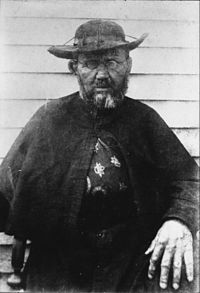When one goes to the Hawaiian Islands, most anticipate arriving in paradise.With year-round temperatures hovering around the low 80s, ocean breezes, and tropical plants, Hawaii is the vacation destination for many. In fact, a popular phrase in Hawaii “Chillaxin”, is a conjunction of the idea of “chilling out” and “relaxing.” Most recently even Disney has entered the scene with opening a resort on Oahu.
Paradise redefined.
Most don’t associate Hawaii with having anything to do with suffering. Most these days would consider being banished to Hawaii a luxury. However, like many communities in the old days, Hawaii once had its own leper colony which was on the Island of Molokai. Native Hawaiians were introduced to many diseases previously unknown to them through foreign sailors and visitors. Leprosy, characterized by disfigurement and rotting flesh, was perceived to be highly contagious and caused widespread hysteria and fear. Anyone suspected of having this condition, also known as Hansen’s disease, was hunted down and banished to a remote area of Molokai. They were forbidden to return to mainstream society. In spite of meager efforts by their government, these persons were left to fend for themselves often being too sick to tend to crops and to build a thriving community. This colony became a wasteland of diseased people. They had inadequate shelter, no healthcare, little food, and unsanitary conditions. The beautiful island of Molokai had turned into a living hell for such people during the 1800s.
“Discolored patches appear on the skin, especially on the cheeks; and the parts affected lose their feeling. After a time this discoloration coves the whole body; then ulcers begin to open, mainly at the extremities. The flesh is eaten away, and gives out a fetid smell; even the breath of the leper becomes so foul that the air around is poisoned with it.” – St. Damien
The ostracized.
One of my kids in reviewing a vocabulary list for school this morning asked me for a definition of ostracized. My pat answer is to look it up in the dictionary; or in keeping modern technology, to do a search for it on an iPhone. But the request brought to my mind that today, May 10, is the Feast Day of St. Damien of Molokai. This saint was all about the ostracized. He is the patron of those with leprosy and the outcast.
St. Damien of Molokai.
St. Damien was born January 3, 1840 in Belgium. He was named Josef de Veuster at birth. He became a Roman Catholic priest through the missionary order of the Congregation of the Sacred Hearts of Jesus and Mary. He volunteered to go to Hawaii in 1864 and after 1873 spent 16 years on the quarantined island of Molokai. In the process of caring for the physical and spiritual needs of the inhabitants, he eventually contracted leprosy himself and died from its complications on April 15, 1889. Pope Benedict canonized him in 2009.
St. Damien did more than care for the spiritual needs of the community. In addition to providing the Sacraments and hearing confessions, he was not inhibited to engage in physical labor which included cleaning and dressing diseased flesh, building and repairing homes, burying the dead, and planting and harvesting crops. These were corporal works of mercy. He gave the ultimate sacrifice of his life to these people. Due to his contact with leprosy, he was banished from mainstream society. He suffered alienation from Hawaiian officials and his religious superiors in Europe. He was also falsely accused of misconduct as leprosy was once mistakenly assumed to be sexually transmitted.
A message for all helpers.
By human nature and by the instinct to survive, many of us may naturally try to keep away from those who are undesirable and pose a potential health risk. We can think of many different types of outcasts in our society. Examples include those who are homeless, whose who are struggling with addictions, those who might be handicapped, those with contagious diseases, and the aging. Sometimes they might even be people who are different in some slight way. Work with these types of persons can be tiring, demanding, and result in being shunned. It is important to be connected to a source of strength and support. There are many saints in history who have exhibited such compassion for the unwanted of society. Examples include St. Francis of Assisi and Blessed Mother Teresa of Calcutta.
St. Damien’s work on Molokai was a testimony to the unselfish love of God and shows where he was able to get his source of strength. In spite of how disfigured and otherwise repulsive the presence of these human beings, Father Damien chose to help them and to try to restore their dignity. St. Damien attributed his ability to do this difficult work to the help of God through the Eucharist:
The Blessed Sacrament is indeed the stimulus for us all, for me as it should be for you, to forsake all worldly ambitions. Without the constant presence of our Divine Master upon the altar in my poor chapels, I never could have persevered casting my lot with the lepers of Molokai; the foreseen consequence of which begins now to appear on my skin, and is felt throughout the body. Holy Communion being the daily bread of a priest, I feel myself happy, well pleased, and resigned in the rather exceptional circumstances in which it has pleased Divine Providence to put me.

